I’m currently working on a Grundig CD903 CD player. It’s a player with a CDM 4/16 transport and a TDA1541A DAC. The 903 is an almost exact copy of the Grundig CD 8400MKII which I also own so I can compare measurements between both players. The only difference is the display, the 903 has a VFD.
I bought this player as faulty from a “vintage audio shop” They claimed it was faulty and that they wanted to repair it but it wasn’t worth repairing it. I asked if they made any changes because I hate to work on equipment with partial repairs. “No, it’s all original” unfortunately they lied about that part.
After opening the CD player I could see some electrolytics caps were removed by cutting the legs on the topside of the PCB and new caps were soldered to the remaining pieces of the cut legs. After removing the main PCB I noticed that the newly tagged on caps made the solder connections on the underside of the PCB come loose.
What were the original symptoms:
What did I do at first:
What are the current symptoms:
What did I do to solve these last problems:
Anybody suggestions on where to start? My knowledge on CD players is limited and I found some topics (like this one) with partially the same problems but they don’t show the solution. Somehow I should be able to see tracking errors but it isn't clear to me how to do this.
The included pictures show the noise and my attempt to measure the frequency of the noise.
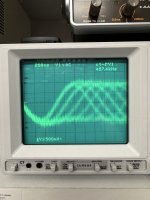
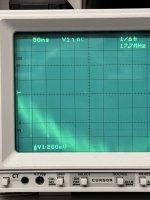
I bought this player as faulty from a “vintage audio shop” They claimed it was faulty and that they wanted to repair it but it wasn’t worth repairing it. I asked if they made any changes because I hate to work on equipment with partial repairs. “No, it’s all original” unfortunately they lied about that part.
After opening the CD player I could see some electrolytics caps were removed by cutting the legs on the topside of the PCB and new caps were soldered to the remaining pieces of the cut legs. After removing the main PCB I noticed that the newly tagged on caps made the solder connections on the underside of the PCB come loose.
What were the original symptoms:
- Up on the first power up the player I noticed that the main fuse (160mA) was blown. After changing the fuse and powering up the player the display came up, the fuse stayed intact.
- Most of the times the CD wouldn’t read a TOC and the swing arm would violently hit the end of it’s range with a loud “cloink” sound. Sometimes it started reading the TOC but wouldn’t play, again violently hitting the end of its range.
What did I do at first:
- Changed most of the axial electrolytic caps and some of the others. All others measure fine.
- Checked rail voltages and compared the ripple on them with my CD 8400MKII, funny thing is that the ripple on the working and fully recapped 8400MKII on some rails is much higher than the CD903. The CD903 does however have some extra electrolytics on the power rails as it has extra voltages for the VFD. I haven't checked yet if they might be of any influence. As the 903 has less ripple then the 8400 I expect this shouldn't be the cause of my problem.
What are the current symptoms:
- The player works and sounds fine but skips pretty fast and the BIAS voltage is very unstable and it’s pretty much impossible to adjust it correctly. At the start of a CD I’m able to turn it up to around 350mV, skipping to the end of the CD the voltage is very unstable and differs between 300mV and 1600mV!
- The eye-pattern has a lot of noise on it. This disappears when I turn up the laser voltage to around 70mV, which is of course no solution. I tried measuring the frequency of the noise and it is somewhere between 15.5 – 17.7 MHz
- When it is playing tracks near the end of the CD and I press the stop button the swing-arm still hits the end of its range with a soft "cloink'", however a less violent then it originally did.
- Sometimes, it appears pretty randomly, the main fuse blows. I can't reproduce when but it might be related to powering on after the swing-arm has hit the end of its range.
What did I do to solve these last problems:
- Swapped the laser / swingarm from a CDM4/19 transport, this doesn’t make any difference.
- Changed the clamp springs for new ones, lubed the clamp.
- Checked the power usage of the spindle motor, the spindle motor that is currently in the transport uses 26mA when a voltage of 3 volts is applied. I compared it to several other spindle motors and the best running only uses 20mA at 3 volts, but others use up to 35mA while running fine. So I don't think the spindle motor is the cause.
Anybody suggestions on where to start? My knowledge on CD players is limited and I found some topics (like this one) with partially the same problems but they don’t show the solution. Somehow I should be able to see tracking errors but it isn't clear to me how to do this.
The included pictures show the noise and my attempt to measure the frequency of the noise.


Last edited:
Thanks for the reply, I didn’t mention but I have a service manual, mine does also describe some service modes but I don’t have any test discs.
There are some people in the forum with a lot of CD player experience. I am not one of them. What I do is get rid of all CD players and rip CDs to wav files. With a good dac (which I know how to make), the sound is far better than I have ever personally heard from a CD player. So when I see people trying to fix old CD players, I guess I don't fully get what that part of the audio hobby is all about.
It’s the same part as people listening to records, looking at the images, choosing which album to listen, putting the cd in the tray, start playing. Skipping around from a digital source doesn’t give the same emotions.
Regarding the quality, I prefer my Grundig 8400MKII above my Parasound D/AC 1100 which should outperform the Grundig by far. How we experience quality is partially based on the personal preferences of the person listening. We can measure any device as much if we want, devices can outperform each other in measurement results but our personal preferences decide what we like best.
Regarding the quality, I prefer my Grundig 8400MKII above my Parasound D/AC 1100 which should outperform the Grundig by far. How we experience quality is partially based on the personal preferences of the person listening. We can measure any device as much if we want, devices can outperform each other in measurement results but our personal preferences decide what we like best.
Don't know much about Parasound dacs. Do know John Curl pretty well. Know he isn't the guy designing Parasound dacs. Know some other professional high end designers as well. One of them has listened to my dac and walked away pretty impressed. He wants one.
Also know some things about measurements versus SQ. Trust me when I say I know how to make a good dac; it isn't as much about measurements as it is about SQ (including a great sound stage).
All things considered, I still am not into the rituals of CDs players nor of vinyl turntables. I have the latter, including technics sp-10 mk3, and DS Audio optical cartridge with custom preamp. Usually I would rather listen to CD rips. The dac is that good.
Also know some things about measurements versus SQ. Trust me when I say I know how to make a good dac; it isn't as much about measurements as it is about SQ (including a great sound stage).
All things considered, I still am not into the rituals of CDs players nor of vinyl turntables. I have the latter, including technics sp-10 mk3, and DS Audio optical cartridge with custom preamp. Usually I would rather listen to CD rips. The dac is that good.
Last edited:
Hi. I barely have any experience in Philips or Grundig CDs players, however:
Look if it have any ROE Roederstein capacitor. It have a good "audiophile"reputation, but in electronic world are crap, maybe is the cause of the blown fuse. I've see in google pictures a big Roederstein capacitor in the power suply.
Check if the componentes replaced are the same value than are shown in service manual.
Check voltages in power suply, check if regulators get hot. Oscilation can be generated by a output dry capacitor in the voltage regulators.
It looks to be a very curious failure.
Edit: Check ore replace tiny axial Philips blue capacitors.
And by the way, I've never have seen the photodiode diagram of a CDM laser pickup, shown when it is focused etc... I did not know it was like this, very ingenious, one laser beam, and two spots in the photodiode array.
Look if it have any ROE Roederstein capacitor. It have a good "audiophile"reputation, but in electronic world are crap, maybe is the cause of the blown fuse. I've see in google pictures a big Roederstein capacitor in the power suply.
Check if the componentes replaced are the same value than are shown in service manual.
Check voltages in power suply, check if regulators get hot. Oscilation can be generated by a output dry capacitor in the voltage regulators.
It looks to be a very curious failure.
Edit: Check ore replace tiny axial Philips blue capacitors.
And by the way, I've never have seen the photodiode diagram of a CDM laser pickup, shown when it is focused etc... I did not know it was like this, very ingenious, one laser beam, and two spots in the photodiode array.
I’m familiar with the roederstein caps, they are changed. All axial caps are replaced for Vishay 021 series caps. Voltage might be a step higher in some cases, capacitance is the same. Other caps used are Panasonic FC and Nichicon FG as coupling caps for the op-amps.
I did upgrade the decoupling caps from the op-amps from 47μF to 100μF. Philips / Marantz etc use 47μF in the budget models and 100μF in the more expensive models. But I can’t imagine that caused the oscillating/noise. Did this before on other players without problem.
I looked at the schematic to see if the ~15-17MHz frequency comes from somewhere else but all oscillators are lower and harmonics don’t come close.
Going to check the regulators tomorrow or this weekend, have checked voltages but didn’t check if they are getting hotter than on the other player.
I did upgrade the decoupling caps from the op-amps from 47μF to 100μF. Philips / Marantz etc use 47μF in the budget models and 100μF in the more expensive models. But I can’t imagine that caused the oscillating/noise. Did this before on other players without problem.
I looked at the schematic to see if the ~15-17MHz frequency comes from somewhere else but all oscillators are lower and harmonics don’t come close.
Going to check the regulators tomorrow or this weekend, have checked voltages but didn’t check if they are getting hotter than on the other player.
👍Going to check the regulators tomorrow or this weekend, have checked voltages but didn’t check if they are getting hotter than on the other player.
It took me a bit more time to do some proper measurements. In my original measurements i primary checked for a 100Hz ripple on the powerlines and if the LM7xxx regulators are stable. After some extra measurements I noticed that with my digital scope I could see the high frequency noise appearing on all power lines. Even +3 & -3, the +15 and -15 volt lines.
I did some thinking how I could come closer to the source and started measuring the HF noise on all power lines on the different IC’S. Once I measured on pin 40 from the SAA7210 I found out the HF noise measures up to ~850mV peak-peak on that pin. The frequency varies from a few kilohertz up to 45+ MHz. If I measure on the other side of inductor DR1 the noise lowers to ~380mV peak-peak. Pin 40 gets its supply from a 7805, IC 12. If I measure the noise directly on the output of IC12 it’s around 50mV. As this is much lower I’m pretty sure the cause of the noise is somewhere around the SAA7210 or maybe the SAA7210 itself is failing. I can’t find the noise on any of the IC’s other inputs so I’m tempted to replace it unless someone else might have a suggestion.
Noise on pin 40 SAA7210.
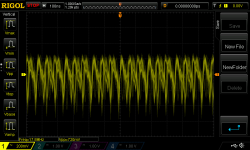
Noise on the other side of DR1.
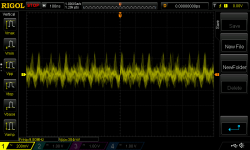
Noise on the output of IC12, LM7805.
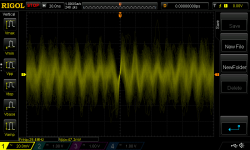
Schematic showing the parts around pin 40 of the SAA7210
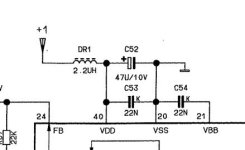
I did some thinking how I could come closer to the source and started measuring the HF noise on all power lines on the different IC’S. Once I measured on pin 40 from the SAA7210 I found out the HF noise measures up to ~850mV peak-peak on that pin. The frequency varies from a few kilohertz up to 45+ MHz. If I measure on the other side of inductor DR1 the noise lowers to ~380mV peak-peak. Pin 40 gets its supply from a 7805, IC 12. If I measure the noise directly on the output of IC12 it’s around 50mV. As this is much lower I’m pretty sure the cause of the noise is somewhere around the SAA7210 or maybe the SAA7210 itself is failing. I can’t find the noise on any of the IC’s other inputs so I’m tempted to replace it unless someone else might have a suggestion.
Noise on pin 40 SAA7210.

Noise on the other side of DR1.

Noise on the output of IC12, LM7805.

Schematic showing the parts around pin 40 of the SAA7210

You have to place the GND of the probe on the right place. It is either pin 20 or the minus leg of C52.
- Home
- Source & Line
- Digital Source
- Grundig 903 - CDM 4/16 transport - Noisy eye-pattern / skipping